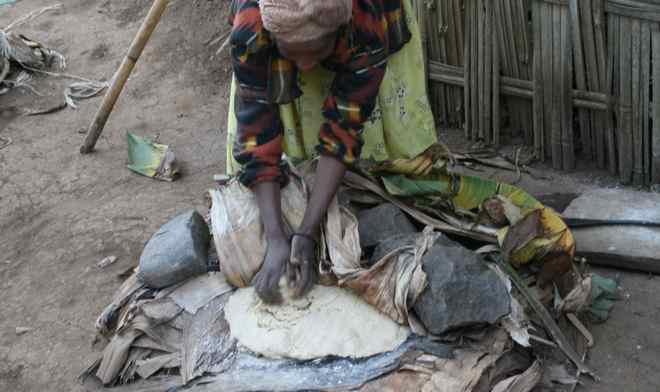Enset is a plant native to Ethiopia that is often referred to as the false banana because, not surprisingly, of its resemblance to the banana plant. It is grown in the less arid highlands of the southwestern region of Ethiopia. Enset contributes to improved food security for approximately 15 million Ethiopians and, according to Ethiopian researchers, there is potential for expanding consumption of the crop. Over the coming weeks, Food Tank will feature different ways in which the enset plant has significant environmental, social, and economic benefits for farmers and consumers.
Over centuries, enset has contributed significantly to the food security of communities in Ethiopia, primarily in the southern highlands. However, its versatility and resilience have distinguished it as a crop with potential for more widespread markets, including in urban areas.
The enset plant takes between three and four years to reach maturity, but once it has, it can be harvested at any time of the year within a five to ten year period. Enset is also a resilient crop. It requires few inputs and once it has taken root, it can tolerate long periods of drought. Because of the crop’s resilience to extreme weather events and the flexibility that farmers have in timing the harvest, enset can provide smallholder farmers with a household food safety net. According to the American Association for the Advancement of Science (AAAS), by cultivating enset crops, smallholder farmers can avoid a “hunger season” that is common among farmers who grow only cereal crops. In addition, enset is a multipurpose crop, and the whole plant can be utilized. The edible parts of the plant are boiled, fermented, or made into flour. The non-edible parts have a variety of uses, from animal feed and roofs to sleeping mats and baby diapers.
Research by the U.N. Food and Agriculture Organization (FAO) finds that food security is more prevalent in enset-based farming systems, as compared to cereal-based farming systems. The region Southern Nations, Nationalities and Peoples (SNNPR), where enset is the main staple crop, has the highest total per capita caloric intake of all Ethiopian regions, and the humid enset-producing highlands have the highest level of caloric intake of all agro-ecological zones in Ethiopia.
Despite its great potential for alleviating food insecurity, enset is grown and consumed in a limited area. In the 2008 and 2009 seasons, enset was produced on only 2.5 percent of total agricultural land in Ethiopia. Furthermore, enset is not typically consumed outside of its areas of cultivation. Markets for the sale of enset are not well developed, and where they exist there are few buyers and farmers generally have poor access to information about market prices and consumer preferences.
Enset is also viewed by many urban dwellers as a “poor person’s food.” There have been signs that this is changing, however, as enset is increasingly sold at urban markets. Restaurants in the Ethiopian capital Addis Ababa have also begun to feature kocho, a dish made with the pulp of the enset root, on their menus. Rising cereal prices may also increase demand for enset products as a cheaper substitution. If demand increases, this can encourage increased enset production and expand the positive impact that enset has on Ethiopian food security.















